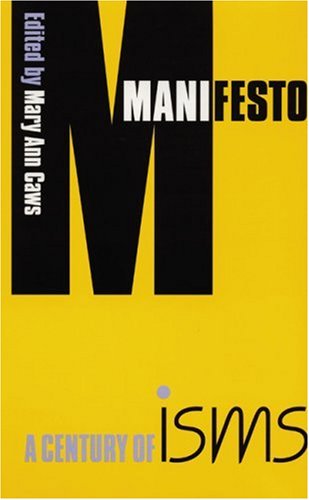Mary Ann Caws (ed.): Manifesto: A Century of Isms (2001)
Filed under book | Tags: · art, art criticism, art history, avant-garde, bauhaus, cubism, dada, de stijl, expressionism, fauvism, futurism, history of literature, imagism, lettrism, literature, manifesto, modernism, surrealism, symbolism, vorticism

“An anthology featuring over 200 artistic and cultural manifestos from a wide range of countries. It includes texts ranging from Kurt Schwitters’ ‘Cow Manifesto’ to those written in the name of well-known movements – imagism, cubism, surrealism, symbolism, and projectivism – and less well-known ones – lettrism, acmeism, concretism, and rayonism.”
Publisher University of Nebraska Press, Lincoln, 2001
ISBN 0803264070, 9780803264076
xxxiv+713 pages
Reviews: Greil Marcus (Artforum, 2001), Publishers Weekly (2001), Gail McDonald (symploke, 2003), Cynthia Ellen Patton (College Literature, 2003).
PDF (14 MB, updated on 2017-11-21)
Comment (0)Theories of Modern Art: A Source Book by Artists and Critics (1968)
Filed under book | Tags: · art criticism, art history, art theory, avant-garde, constructivism, cubism, dada, expressionism, fauvism, futurism, neoplasticism, post-impressionism, surrealism, symbolism

“A collection of texts from letters, manifestos, notes and interviews. Sources include, as the title says, artists and critics—some expected, like van Gogh, Gauguin, Apollinaire, Mondrian, Greenberg, just to name a few—and some less so: Trotsky and Hitler, in the section on Art and Politics. The book is a wonderful resource and insight into the way artists think and work.”
Edited by Herschel Browning Chipp
Contributions by Peter Selz and Joshua C. Taylor
Publisher University of California Press, 1968
ISBN 0520014502
xv+664 pages
Reviews: Romare H. Bearden and Carl Holty (Leonardo, 1970), Elizabeth Gilmore Holt (Art Bulletin, 1972).
PDF (179 MB, no OCR)
Comment (0)Alfred H. Barr, Jr.: Cubism and Abstract Art: Painting, Sculpture, Constructions, Photography, Architecture, Industrial Art, Theatre, Films, Posters, Typography (1936)
Filed under book, catalogue | Tags: · abstract art, abstraction, architecture, art, art history, avant-garde, constructivism, cubism, dada, design, expressionism, fauvism, film, futurism, impressionism, painting, photography, sculpture, suprematism, surrealism, theatre, typography

The catalogue of the first MoMA’s retrospective of modernism, held 2 March-19 April 1936, laid the theoretical foundation of the museum. Its jacket contains a notorious chart of modernist art history, the Diagram of Stylistic Evolution from 1890 until 1935.
“The catalogue remains an important historical document (as does that for Fantastic Art, Dada, Surrealism). It set abstraction within a formalist framework that—ignoring the intellectual byways of French symbolism, German idealism, and Russian Marxism of the previous thirty years—was shaped by the scientific climate that had started a century before. … The exhibition together with the widespread dissemination of its influential catalogue, established Cubism as the central issue of early modernism, abstraction as the goal.” (Sybil Gordon Kantor, 2003)
The exhibition later traveled to another 7 cities: San Francisco, Cincinnati, Minneapolis, Cleveland, Baltimore, Providence, and Grand Rapids.
Publisher Museum of Modern Art, New York, 1936
249 pages
via MoMA
Commentary: Meyer Schapiro (Marxist Quarterly, 1937), Susan Noyes Platt (Art Journal, 1988), Astrit Schmidt Burkhardt (Word & Image, 2000).
Publisher (incl. master checklist and press releases)
WorldCat
PDF (47 MB)
Comment (1)
